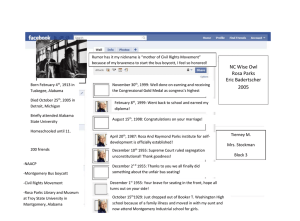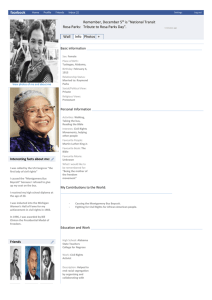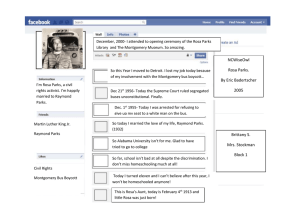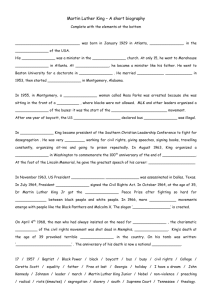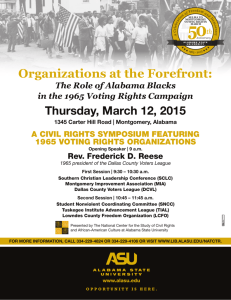Rosa Parks and the Montgomery Bus Boycott, 1955-56
advertisement
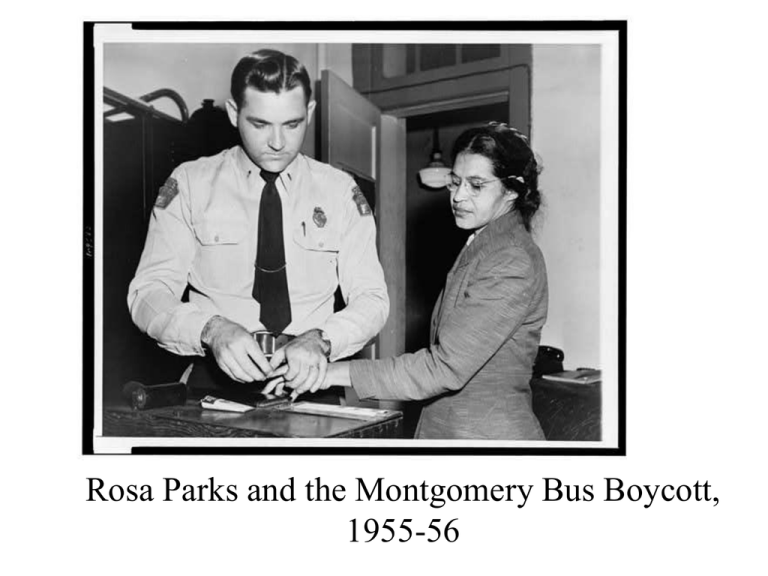
Rosa Parks and the Montgomery Bus Boycott, 1955-56 Rosa Parks Not long ago it was legal to discriminate against black people in the United States. That’s when Rosa McCauley was growing up in Montgomery, Alabama. When Rosa was 11, she went into a store with her cousin, Annie Mae, who asked for a soda. The answer: “We don’t serve sodas to colored people.” This was legal, but Rosa knew it was wrong. Years later, in 1955, Rosa Parks (her married name) had a chance to act courageously on her convictions. By law, black people had to sit in the back of city buses and stand if a white person needed a seat. Parks refused to give up her seat to a white man. She was arrested. This led blacks to boycott, or not use, Montgomery buses until the unjust law was changed. Rosa Parks has been called the “mother of the civil rights movement.” National Geographic http://www.nationalgeographic.com/ngkids/9802/rosaparks/ Lunch Counter Sit–in, Jackson Mississippi, 1963 The Sit-In Movement In addition to Martin Luther King Jr., many individuals, including students, helped lead the struggle for African American civil rights. Black youth began to peacefully demonstrate by sitting at “whites only” lunch counters to protest segregated facilities. Black and white students joined in the “sit ins” and as a peaceful way to demonstrate against unfair policies. March on Washington, 1963 The 1963 March on Washington Over a quarter of a million people from across the nation gathered in front of the Lincoln Memorial in August 1963. The march was successful and received great publicity. Martin Luther King, Jr. and the March on Washington, 1963 Martin Luther King Jr.’s Dream The most positive and memorable speech of the day came from King. “I have a dream that one day this nation will rise up and live out the true meaning of its creed: ‘We hold these truths to be self-evident: that all mean are created equal’ he said. “I have a dream that my four children. . .will not be judged by the color of their skin but by the content of their character.” In the spring of 1964, President Lyndon B. Johnson signed the civil rights bill into law. The Civil Rights Act of 1964 banned the separation of people based on race, called segregation, in public places. It made it illegal to discriminate against a person when hiring based on his or her skin color, race, religion and national origin. The act also banned discrimination against women seeking jobs Freedom Summer, 1964 Freedom Summer Over 1,000 volunteers traveled to Southern cities and towns in the summer of 1964. They went door-to-door to meet residents and held classes on how to fill out voter registration forms and answer questions. Workers tried to build confidence and motivation toward becoming active citizens in their communities. Selma-toMontgomery march, 1965 Voting Rights On March 7, 1965, hundreds of civil rights supporters attempted a historic 54-mile march from Selma to Montgomery, Alabama. They were protesting laws that prevented African Americans from voting in Alabama, but they were stopped and attacked by police shortly after starting. On Sunday, March 21, about 3,200 marchers set out again. When they arrived in Montgomery on March 25, there were about 25,000 protesters from around the country who completed the march. Their efforts helped pass the 1965 Voting Rights Act, which guaranteed voting rights for everyone
